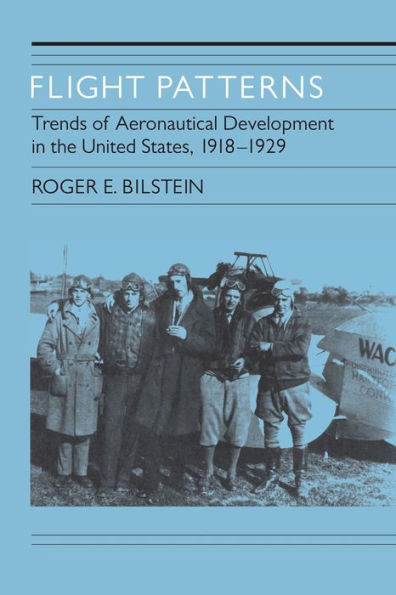Flight Patterns: Trends of Aeronautical Development In the United States, 1918-1929
From 1918 to 1929 American aviation progressed through the pioneering era, establishing the pattern of its impact on national security, commerce and industry, communication, travel, geography, and international relations. In America, as well as on a global basis, society experienced a dramatic transformation from a two-dimensional world to a three-dimensional one. By 1929 aviation was poised at the threshold of a new epoch.
Covering both military and civil aviation trends, Roger Bilstein's study highlights these developments, explaining how the pattern of aviation activities in the 1920s is reflected through succeeding decades. At the same time, the author discusses the social, economic, and political ramifications of this robust new technology.
Aviation histories usually pay little attention to aeronautical images as an aspect of popular culture. Thoughtful observers of the 1920s such as Stuart Chase and Heywood Broun considered aircraft to be an encouraging example of the new technology-workmanlike, efficient, and graceful, perhaps representing a new spirit of international good will. Flight Patterns is particularly useful for its discussion of both economic and cultural factors, treating them as integrated elements of the evolving air age.
1115416317
Covering both military and civil aviation trends, Roger Bilstein's study highlights these developments, explaining how the pattern of aviation activities in the 1920s is reflected through succeeding decades. At the same time, the author discusses the social, economic, and political ramifications of this robust new technology.
Aviation histories usually pay little attention to aeronautical images as an aspect of popular culture. Thoughtful observers of the 1920s such as Stuart Chase and Heywood Broun considered aircraft to be an encouraging example of the new technology-workmanlike, efficient, and graceful, perhaps representing a new spirit of international good will. Flight Patterns is particularly useful for its discussion of both economic and cultural factors, treating them as integrated elements of the evolving air age.
Flight Patterns: Trends of Aeronautical Development In the United States, 1918-1929
From 1918 to 1929 American aviation progressed through the pioneering era, establishing the pattern of its impact on national security, commerce and industry, communication, travel, geography, and international relations. In America, as well as on a global basis, society experienced a dramatic transformation from a two-dimensional world to a three-dimensional one. By 1929 aviation was poised at the threshold of a new epoch.
Covering both military and civil aviation trends, Roger Bilstein's study highlights these developments, explaining how the pattern of aviation activities in the 1920s is reflected through succeeding decades. At the same time, the author discusses the social, economic, and political ramifications of this robust new technology.
Aviation histories usually pay little attention to aeronautical images as an aspect of popular culture. Thoughtful observers of the 1920s such as Stuart Chase and Heywood Broun considered aircraft to be an encouraging example of the new technology-workmanlike, efficient, and graceful, perhaps representing a new spirit of international good will. Flight Patterns is particularly useful for its discussion of both economic and cultural factors, treating them as integrated elements of the evolving air age.
Covering both military and civil aviation trends, Roger Bilstein's study highlights these developments, explaining how the pattern of aviation activities in the 1920s is reflected through succeeding decades. At the same time, the author discusses the social, economic, and political ramifications of this robust new technology.
Aviation histories usually pay little attention to aeronautical images as an aspect of popular culture. Thoughtful observers of the 1920s such as Stuart Chase and Heywood Broun considered aircraft to be an encouraging example of the new technology-workmanlike, efficient, and graceful, perhaps representing a new spirit of international good will. Flight Patterns is particularly useful for its discussion of both economic and cultural factors, treating them as integrated elements of the evolving air age.
29.95
In Stock
5
1

Flight Patterns: Trends of Aeronautical Development In the United States, 1918-1929
260
Flight Patterns: Trends of Aeronautical Development In the United States, 1918-1929
260Paperback
$29.95
29.95
In Stock

Product Details
| ISBN-13: | 9780820332147 |
|---|---|
| Publisher: | University of Georgia Press |
| Publication date: | 12/01/2008 |
| Pages: | 260 |
| Product dimensions: | 6.00(w) x 9.00(h) x 0.60(d) |
About the Author
From the B&N Reads Blog
